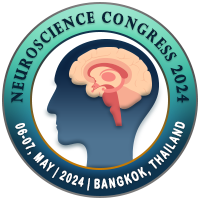
Yegnanarayanan Venkataraman
Kalasalingam Academy of Research and Education, IndiaTitle: Graph theory for better comprehension of Alzheimer’s Disease
Abstract
The human brain has more than 1010 neurons that attract counsel through more than a 1013 synapses and it processes, disseminates, transforms and facilitates interactions between brain cells and makes us to feel, think, move and maintains homeostasis concurrently. To decode the process of communication between brain cells, we need to comprehend the attributes of neuronal interactions. For this, diffusion imaging is employed by noticing the changes in white matter make-up through measures that could be sensitive to fiber integrity and microstructure. Also one need to perform tractography to bring out neural pathways that results in mathematical metrics explaining the “connectomics” of brain networks. For this purpose, Graph Theory-GT is a useful tool to visulaize the topological organization of the white matter structure. Then with algebraic connectivity of brain networks, can be seen with linear algebra and matrix theory to probe the attributes of graphs. This attempt led to finding of potential biomarkers for comprehending white matter deterioration in the brain that could lead to Alzheimer’s disease-AD and all of its clinical stages, including frontotemporal dementia. Loss of attention, concentration, memory, calculation occurs when AD sets in and the stage between normal ageing and AD is called Mild cognitive impairment-MCU. GT is applied in the process of determining how functional connectivity disturbances could describe dysfunction in AD. It isolates topological attributes of brain functional networks in the form of a graph G= (V, E) with vertex set V = fMRI signals from the brain regions and edge set E = intermodal correlation coefficients as a measure of functional connectivity among vertices. BRAPH-Brain Analysis Using Graph Theory, is a MatLab bases software available for in google platform for the purpose of connectivity analysis of brain networks obtained from MRI, fMRI, PET-positron emission tomography and EEG data. It permits construction of connectivity matrices, for finding cluster coefficient-CC and path length-PL to do non-parametric permutations for group comparisons. That is, lower CC and higher PL values in AD group means diverse neural network changes resulting in less efficient brain organization. Evidence is available in literature on how AD-induced changes affect long-distance connectivity. A careful review of counsel from databases such as Science Direct, Scopus, Google Scholar, IEEE Xplore, PubMed, SpringerLink etc., reveals the use of Cochrane Collaboration’s tool to estimate the risk of bias. It is attracting the researchers attention since 2009. Another aspect to explain network attributes and is Graph Spectral Analysis-GSA. It is applied to MEG data to probe functional network integrity in AD. Global loss of connectivity and altered synchronizability was observed in most frequency bands. The eigenvector centrality mapping reveals the hub status of the parietal areas. It also showed a low centrality at left temporal region of the theta band in AD patients when subjected to mini mental state examination. To conclude, GT serves as both a prominent technique and a useful tool for analysing neurological diseases such as AD. Keywords: Brain networks, Graph Theory, Graph Spectral Analysis, Alzheimer’s disease, Correlation coefficient, Path Length, BRAPH
Biography
Yegnanarayanan, is an accomplished Senior Professor of Mathematics with strong leadership abilities honed as Dean & Director. Strong abilities in team leadership and Project Management backed by Research, Teaching and Faculty Mentoring. He is Known for his Excellent Leadership and Communicative skills and commitment to achieving goals. He has Demonstrated success in training team members, conducting evaluations and reviewing records. He exhibits Excellent attention to detail with Strong Organizational skills. He is Safety-driven and disciplined with a remarkable work ethic. He Possess skills in Tactics Development, Assessing risks, Briefing leadership, Training expertise, Administrative support, and in Strategic Planning. He has so far published more than 200 research articles in reputed journals.

